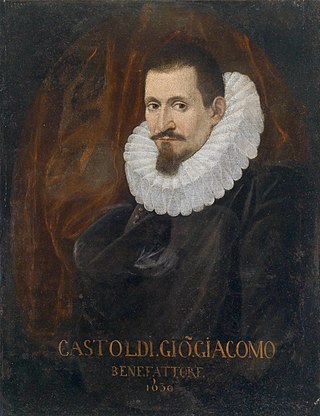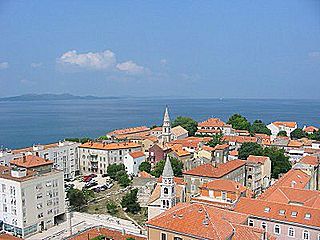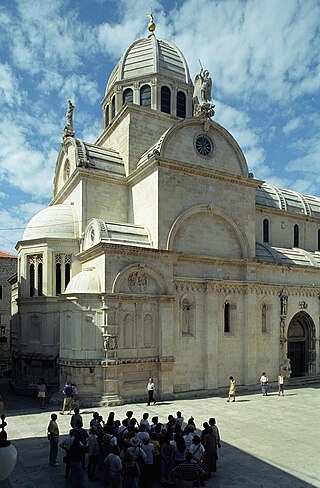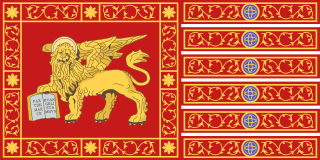
Dalmatia is one of the four historical regions of Croatia, alongside Central Croatia, Slavonia and Istria, located on the east shore of the Adriatic Sea in Croatia.
The music of Croatia, like the divisions of the country itself, has two major influences: Central European, present in central and northern parts of the country including Slavonia, and Mediterranean, present in coastal regions of Dalmatia and Istria.

Trogir is a historic town and harbour on the Adriatic coast in Split-Dalmatia County, Croatia, with a population of 10,923 (2011) and a total municipal population of 13,192 (2011). The historic city of Trogir is situated on a small island between the Croatian mainland and the island of Čiovo. It lies 27 kilometres west of the city of Split.

Šibenik, historically known as Sebenico, is a historic city in Croatia, located in central Dalmatia, where the river Krka flows into the Adriatic Sea. Šibenik is a political, educational, transport, industrial and tourist center of Šibenik-Knin County, and is also the third-largest city in the Dalmatian region. As of 2011, the city has 34,302 inhabitants, while the municipality has 46,332 inhabitants.

Salamone Rossi or Salomone Rossi was an Italian Jewish violinist and composer. He was a transitional figure between the late Italian Renaissance period and early Baroque.
Giovanni Bassano was an Italian composer associated with the Venetian School of composers and a cornettist of the late Renaissance and early Baroque eras. He was a key figure in the development of the instrumental ensemble at the basilica of San Marco di Venezia. His detailed book on instrumental ornamentation has survived. It is a rich resource for research in contemporary performance practice. Bassano was most responsible for the performance of the music of Giovanni Gabrieli, who would emerge as one of the most renowned members of the Venetian School.

Giovanni Giacomo Gastoldi was an Italian composer of the late Renaissance and early Baroque periods. He is known for his 1591 publication of balletti for five voices.
Stari Grad is a town on the northern side of the island of Hvar in Dalmatia, Croatia. One of the oldest towns in Europe, its position at the end of a long, protected bay and next to prime agricultural land has long made it attractive for human settlement. Stari Grad is also a municipality within the Split-Dalmatia County.

Giorgio da Sebenico or Giorgio Orsini or Juraj Dalmatinac was a Venetian sculptor and architect from Dalmatia, who worked mainly in Sebenico, and in the city of Ancona, then a maritime republic.

Dalmatian Italians are the historical Italian national minority living in the region of Dalmatia, now part of Croatia and Montenegro.
Croatian art describes the visual arts in Croatia, and art by Croatian artists from prehistoric times to the present. In Early Middle Ages, Croatia was an important centre for art and architecture in south eastern Europe. There were many Croatian artists during the Medieval period, and the arts flourished during the Renaissance. Later styles in Croatia included Baroque and Rococo.
Marko Ivan Lukačić was a Croatian-born musician and composer of the Renaissance and early Baroque.
Ensemble Renaissance is the first early music ensemble in Serbia and the second in south-eastern Europe, having been founded in 1968. Ensemble Renaissance usually focuses on the music of the Middle Ages, Renaissance and Baroque. Occasionally, however, Ensemble performs modern music on ancient instruments.

Fishing and Fishermen's Talk also translated as Fishing and Fishermen's Conversations(Croatian: Ribanje i ribarsko prigovaranje) is the most important literary work of Croatian Renaissance poet Petar Hektorović, finished on January 14, 1556, and printed in 1568 in Venice. Ribanje is a pastoral and philosophic narrative poem in three parts in which Hektorović describes in a letter to his cousin, his three-day boat trip from Hvar to Brač and Šolta, accompanied by a pair of Hvar fishermen, Paskoje Debelja and Nikola Zet.
Bugarštica, originally known as Bugaršćica, is a form of epic and ballad oral poetry, which was popular among South Slavs mainly in Dalmatia and Bay of Kotor from 15th until the 18th century, sung in long verses of mostly fifteen and sixteen syllables with a caesura after the seventh and eighth syllable, respectively.

The Renaissance in Croatia is a period of cultural enrichment in Croatia that began at the middle of the 15th century and lasted until the end of the 16th century.
Vincenzo Comneno (1590–1667) was a musician and madrigal composer of the Renaissance and early Baroque from the Republic of Ragusa.

Music of Old Adriatic is a vinyl album by Ensemble Renaissance, released in 1984 on the PGP RTB label. It is their first album with early music of Dalmatia and Adriatic and their second album overall. The A side of the record deals with the composers who were born on the territory of modern Dalmatia, in the parts which were Venetian at the time, such as Andrea Antico, Franciscus Bossinensis and Giacomo Gorzanis. The B side deals with authentic Dalmatian composers of the renaissance, like Petar Hektorović. The ensemble will revisit the theme of the early Dalmatian music in 1999 with their CD Journey through Dalmatia.

Venetian Dalmatia refers to parts of Dalmatia under the rule of the Republic of Venice, mainly from the 15th to the 18th centuries. Dalmatia was first sold to Venice in 1409 but Venetian Dalmatia was not fully consolidated until 1420. It lasted until 1797, when the Republic of Venice fell to the forces of Napoleon Bonaparte and Habsburg Austria.
Joško Ćaleta is a Croatian ethnomusicologist, music pedagogue, conductor, composer, record producer and klapa singer.











